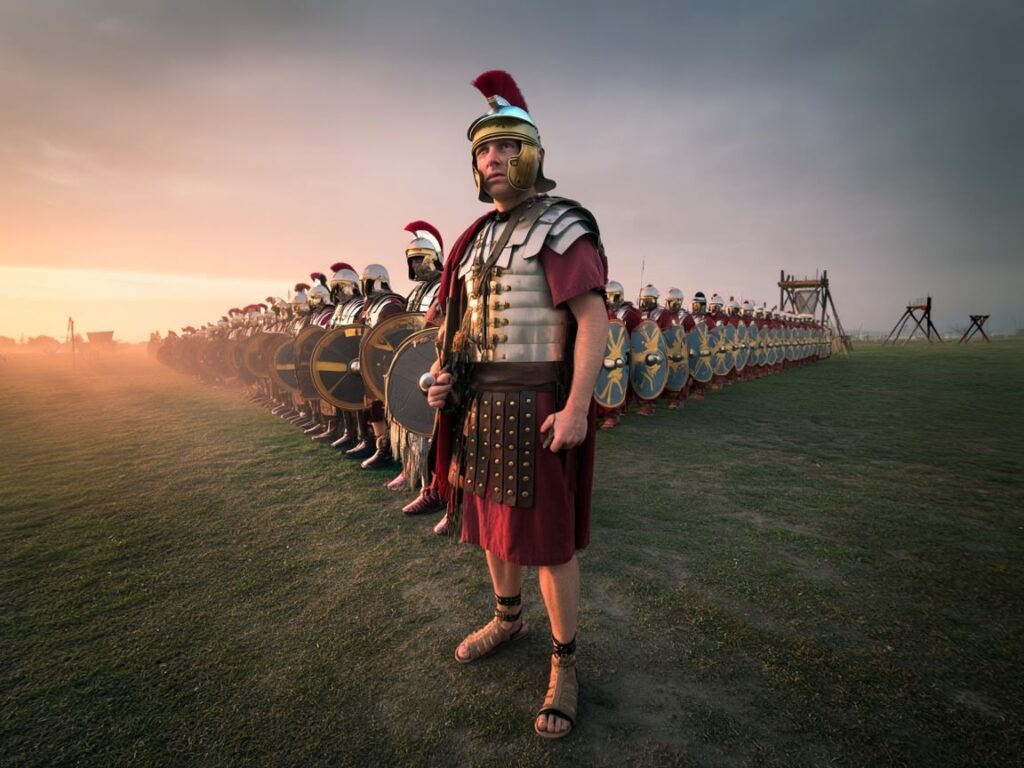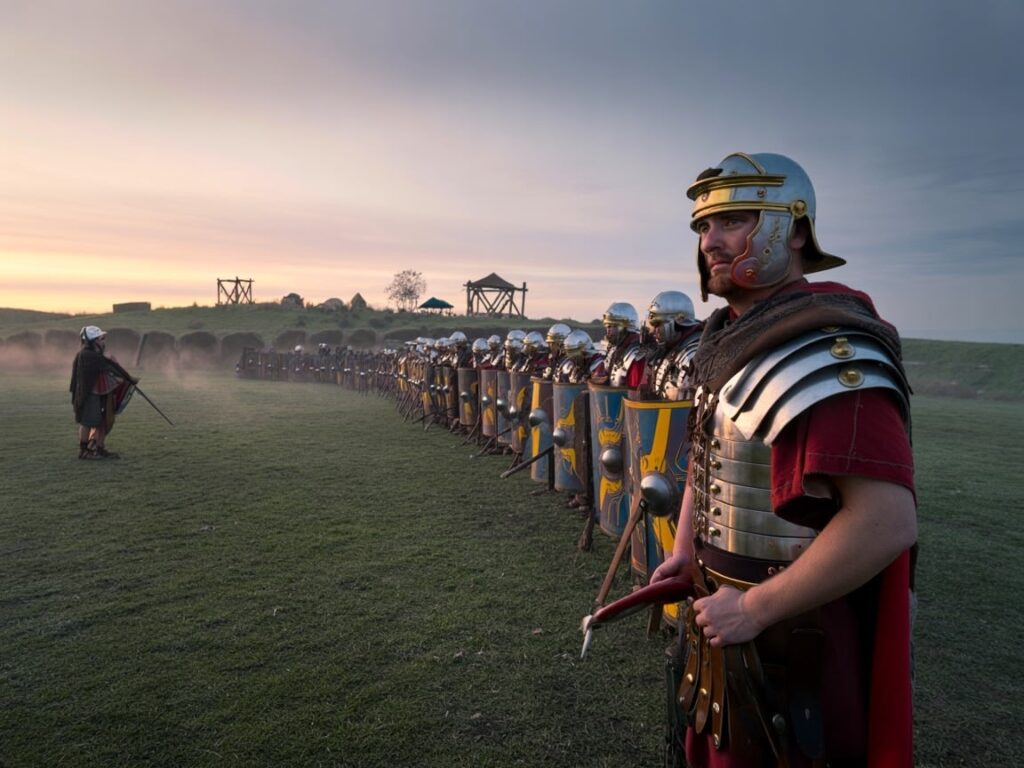Roman military innovations in strategy, organization, and engineering set the foundation for warfare techniques that echo in European armies to this day. How did these ancient tactics shape modern military doctrine?
A replica Roman legionnaire in formation, showcasing the disciplined, flexible infantry tactics that influenced centuries of European warfare.
In the shadowed fields of antiquity, a disciplined force of Roman legionaries clashed with diverse foes using tactics that would outlast their empire. Armed not only with weapons but with a strategy grounded in flexibility, organization, and engineering, the Roman military forged a model of warfare that continues to inform modern armies. This article examines how Roman military organization, such as their three-line infantry formation and the legion’s modular cohorts, combined with innovative siege engineering and logistical infrastructure, influenced modern military strategies. We begin by exploring the historical genesis of these tactics, then detail Roman battlefield and engineering practices, analyze their adaptation through European histories, engage historiographical debates, and conclude with their enduring legacies.
Context and Genesis
Roman military strategy evolved from early tribal warfare, marked by phalanx formations, into a highly systematized legion-based army by the third century BCE. The maniple system divided units into hastati, principes, and triarii, a flexible setup allowing independent operation and tactical depth. The Marian reforms of 107 BCE further professionalized this force, creating standardized legions that formed the backbone of Rome’s expansion. Each soldier carried tools for rapid fortification building, reflecting the army’s engineering prowess.
Concurrently, Roman military engineering flourished, with legions constructing fortified camps (castra) nightly and roads enabling rapid troop movement. Julius Caesar’s Rhine bridge is emblematic of this capability, built swiftly to impress and outmaneuver foes. Their siege engines, including ballistae, onagers, siege towers, and battering rams, augmented their capacity to conduct successful campaigns against fortified cities. This blend of tactical discipline and engineering made Rome’s military a resilient and imposing force.

Documented Roman Tactics and Engineering
Roman legions utilized a coherent tactical deployment structured into three ranks for battlefield engagement: the young hastati at the front, the more experienced principes behind, and veteran triarii as a final reserve. This layering allowed fresh troops to rotate forward as earlier lines fatigued, maintaining combat pressure and flexibility. The checkerboard (quincunx) formation ensured gaps for maneuver and retreat without disorder.
Siege warfare was approached methodically. Roman engineers quickly erected battering rams protected by testudo-like shelters, constructed intricate siege towers, and employed precise artillery fire from ballistae and onagers. The siege of Alesia exemplifies their engineering mastery, building dual circumvallation walls over 20 km long to confine enemies. These innovations were complemented by logistical networks: roads, bridges, and fortified camps to secure supply lines and troop readiness.

Causality and Adaptation in Later European Armies
Roman military concepts—rigorous training, unit cohesion, tactical flexibility—provided a blueprint adapted by medieval and early modern European forces. The concept of the legion evolved into professional standing armies, while fortification technologies influenced castle and city defenses into the Renaissance.
The three-line infantry formation inspired linear tactics, enabling sustained pressure and sequential troop deployment in later European conflicts. Siege engines, technologies for undermining walls and artillery deployment, informed medieval siegecraft. Roman road networks prefigured military logistics that emphasize rapid troop movement and operational reach.
European military thinkers studied Roman campaigns, adapting formations to horse-mounted cavalry and gunpowder artillery developments but retaining the organizational core of discipline and engineering ingenuity.
Historiographical Debates and Controversies
Scholarship debates the degree to which Roman tactics directly shaped modern military doctrines versus parallel independent developments. Some argue that Renaissance military treatises selectively revived Roman ideas, blending them with contemporary innovations. Others emphasize that universal principles of organization and engineering naturally recur in warfare, independent of Roman legacy.
Additionally, the transition from heavy infantry dominance to cavalry and firearm-centered warfare complicates straightforward lineage claims. Yet, the enduring respect for Roman discipline, training rigor, and logistical foresight remains uncontested.

Consequences and Legacies
Roman military innovations underpin many foundational elements of modern warfare: professional standing armies, use of engineering corps, and strategic infrastructure development. Their insistence on fortification construction, tactical flexibility, and relentless adaptability is echoed in modern doctrines emphasizing mobility, layered defense, and integrated arms.
Contemporary militaries still employ variations of Roman siege techniques, and principles of operational reach advanced by their road networks inform present-day rapid deployment strategies. The Roman emphasis on combined arms, training, and psychological impact persists in military education worldwide.

Conclusion
The Roman military was not merely an instrument of conquest but a crucible of tactical, organizational, and engineering innovation whose influence reverberates through centuries. Roman tactics crafted a strategic and practical framework that, adapted to evolving technology and contexts, served as a foundation for European military development. Recognizing this heritage deepens understanding of modern warfare’s roots in disciplined coordination, infrastructural mastery, and engineering ingenuity.
Historical Milestones in Roman Military Evolution
- Early Republic: Phalanx to manipular system transition with three distinct lines.
- 107 BCE: Marian reforms professionalize and standardize legion structure.
- Late Republic/Empire: Cohort formation and testudo preserve tactical flexibility.
- Engineering feats like Caesar’s Rhine bridge and siege of Alesia revolutionize military logistics and siegecraft.
Debates on Roman Influence vs. Independent Military Practices
- Some historians assert direct lineage of Roman tactics in modern armies.
- Others highlight parallel evolution of military concepts in post-Roman Europe.
- Consensus: Roman discipline, engineering, and tactical innovation set foundational principles, even if adapted over time.
Credits and Sources
This article synthesizes research from academic military history resources, including studies on Roman infantry tactics, engineering accounts by Vitruvius, archaeological findings of legionary sites and fortifications, and modern analyses of European military evolution. Key historical texts include writings of Polybius, Vegetius, Julius Caesar’s War in Gaul, and contemporary military historians such as Adrian Goldsworthy. Additional insights derive from technical investigations of siege engines and battlefield formations.

